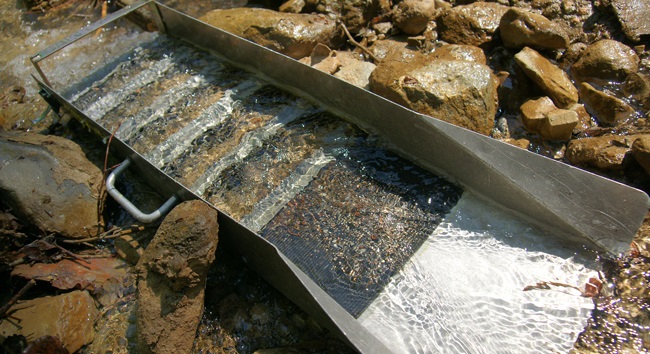
Sluice boxes are probably the best tool for the average prospector to find gold nuggets. This is because they are simple, inexpensive, and effective tools used to recover gold from a creek or river.
While gold pans are certainly the most popular piece of equipment for finding gold, sluice boxes are designed to process a lot more gravel than just a gold pan. You can get the gold out of many times more gravel spending the day sluicing than you can will just a gold pan. And they work great for capturing gold from tiny dust up to nice gold nuggets.
Commercial Sluices are Money Well Spent
Lots of miners like to make their own sluice boxes, but commercially made sluices are available that work excellent and are very inexpensive. They are also lightweight, which is a nice feature if you need to hike into your mining area.
To find gold nuggets with a sluice box, you first need to find an area that actually has gold nuggets. After all, you can’t find them if they aren’t there!
Most of the states in the western U.S. have gold nuggets in certain rivers, as well as parts of the Appalachian Mountains in the Southeast, and even a few places in the Northeast have some gold nuggets that you can find with a sluice, although most of the gold here is finer textured.
Sampling an area with a gold pan, BEFORE you set up your sluice is always smart. Use your gold pan and test a few different areas. If you start finding good gold at the bottom of your pan, set up your sluice box nearby and start digging!
Setting Up Your Sluice Box to Find Gold Nuggets
The proper operation of a sluice is relatively simple. The most important thing to remember if you want to capture gold nuggets is to have good flow through the sluice over the riffles, but not so much that gold shoots through and out the back of the box. This might take a bit of trial-and-error, but eventually you will learn how much flow is ideal for your sluice.
You can shovel gravel directly into the head of your sluice box, but it’s a good idea to classify your gravel before adding it to the sluice. This prevents large rocks from adding extra turbulence around the riffles of the sluice, which can cause a gold nugget to be dislodged and ejected out the back.
Add material slowly at first, and watch how it works through your sluice box. You should be able to watch the sands and gravel slowly tumble down through the sluice. If you are lucky, maybe a nice nugget will show up at the head of the sluice!
Most of your gold should get captured in the first part of the sluice. If you are finding considerable gold way down toward the bottom of the sluice box, you likely have too much flow going through your box.
Also Read: Finding Gold in Quartz Rock
Capturing Your Gold Nuggets
If you see any gold nuggets in the riffles, carefully remove the sluice from the river. Use tweezers to pick the larger flakes and nuggets out and put them in your vial.
Transfer the black sands from your carpeting or miners moss into a bucket. You can process this material when you get home using a gold pan. Spend your time on the river digging for more gold!
Sluice boxes do a great job finding gold nuggets down to even the fine gold. They are a great choice for the prospector who wants to find more gold than they are with just a gold pan alone. If you are in an area that produces gold nuggets and you run enough material through your sluice box, you will find one!
Next: Crevicing for Gold on Bedrock

